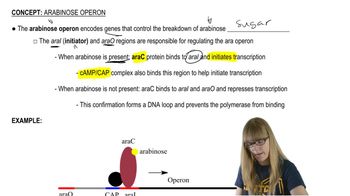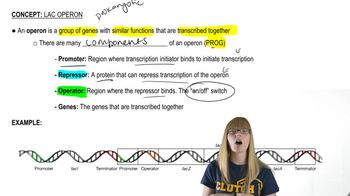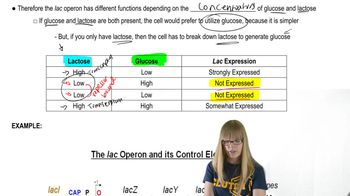Table of contents
- 1. Introduction to Genetics51m
- 2. Mendel's Laws of Inheritance3h 37m
- 3. Extensions to Mendelian Inheritance2h 41m
- 4. Genetic Mapping and Linkage2h 28m
- 5. Genetics of Bacteria and Viruses1h 21m
- 6. Chromosomal Variation1h 48m
- 7. DNA and Chromosome Structure56m
- 8. DNA Replication1h 10m
- 9. Mitosis and Meiosis1h 34m
- 10. Transcription1h 0m
- 11. Translation58m
- 12. Gene Regulation in Prokaryotes1h 19m
- 13. Gene Regulation in Eukaryotes44m
- 14. Genetic Control of Development44m
- 15. Genomes and Genomics1h 50m
- 16. Transposable Elements47m
- 17. Mutation, Repair, and Recombination1h 6m
- 18. Molecular Genetic Tools19m
- 19. Cancer Genetics29m
- 20. Quantitative Genetics1h 26m
- 21. Population Genetics50m
- 22. Evolutionary Genetics29m
12. Gene Regulation in Prokaryotes
Lac Operon
Problem 2c
Textbook Question
Transcriptional regulation of operon gene expression involves the interaction of molecules with one another and of regulatory molecules with segments of DNA. In this context, define and give an example of each of the following: positive regulation
 Verified step by step guidance
Verified step by step guidance1
Understand that transcriptional regulation involves controlling the rate at which genes are transcribed to mRNA, which is crucial for gene expression.
Recognize that positive regulation refers to the process where a regulatory protein, known as an activator, binds to DNA and increases the transcription of a gene or operon.
Identify that in positive regulation, the activator protein typically binds to a specific site on the DNA, often near the promoter region, facilitating the binding of RNA polymerase to the promoter.
Consider the example of the lac operon in E. coli, where the catabolite activator protein (CAP) acts as an activator. When glucose levels are low, cyclic AMP (cAMP) levels increase, allowing CAP to bind to cAMP and then to the DNA, enhancing transcription of the lac operon.
Reflect on how positive regulation is essential for cells to respond to environmental changes by turning on genes that are needed under specific conditions.
Recommended similar problem, with video answer:
 Verified Solution
Verified SolutionThis video solution was recommended by our tutors as helpful for the problem above
Video duration:
5mPlay a video:
Was this helpful?
Key Concepts
Here are the essential concepts you must grasp in order to answer the question correctly.
Transcriptional Regulation
Transcriptional regulation refers to the mechanisms that control the transcription of genes, determining when and how much of a gene's product is produced. This process involves various proteins, including transcription factors, that bind to specific DNA sequences to either promote or inhibit the transcription of target genes. Understanding this concept is crucial for grasping how cells respond to internal and external signals.
Recommended video:
Guided course

Eukaryotic Transcription
Operon
An operon is a cluster of genes under the control of a single promoter and regulatory elements, allowing for coordinated expression of genes that often encode proteins with related functions. In prokaryotes, operons enable efficient regulation of gene expression in response to environmental changes. The classic example is the lac operon in E. coli, which is involved in lactose metabolism.
Recommended video:
Guided course

Arabinose Operon
Positive Regulation
Positive regulation is a form of gene regulation where a regulatory molecule, often a transcription factor, enhances the transcription of a gene or operon. This occurs when the regulator binds to a specific site on the DNA, facilitating the recruitment of RNA polymerase and promoting gene expression. An example is the CAP protein in the lac operon, which activates transcription in the presence of cAMP when glucose levels are low.
Recommended video:
Guided course

Positional Cloning

 4:27m
4:27mWatch next
Master Lac Operon Overview with a bite sized video explanation from Kylia Goodner
Start learning



